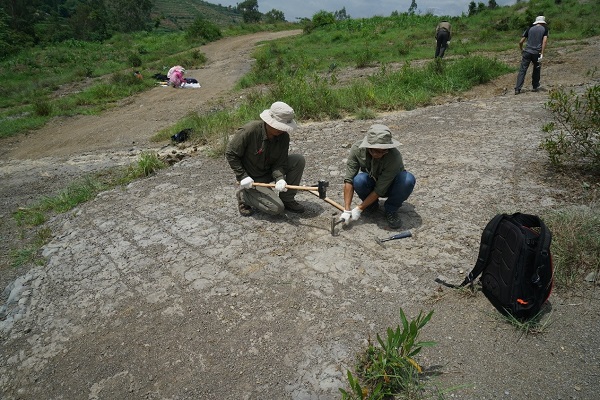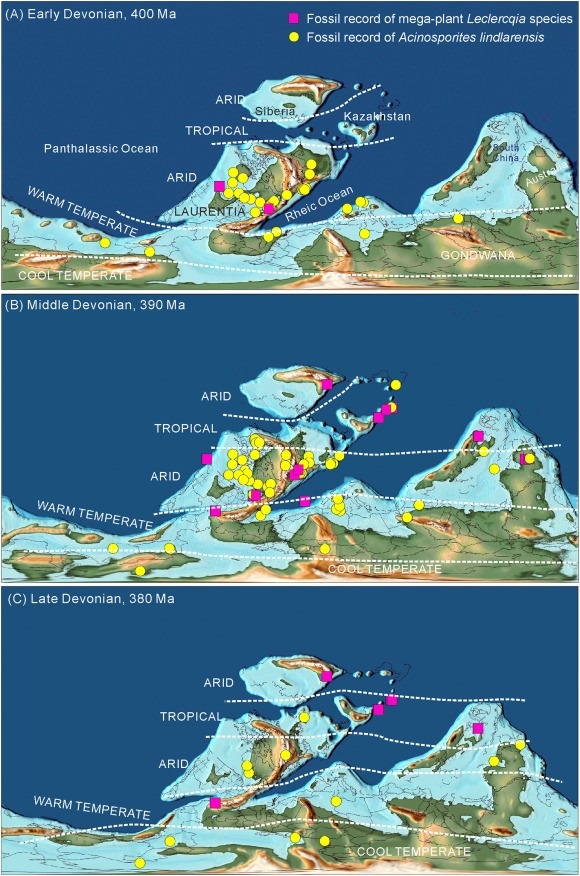The Devonian Period witnessed the great diversification of land plants and the first development of complex terrestrial ecosystems. Palaeogeographic distribution and differentiation of Devonian plants was recognized from abundant mega- and micro-plant fossil records, both endemic and widely-spread plants, available globally and correspond to the different palaeocontinents present in the Devonian. Herbaceous lycopsid, such as the protolepidodendraleans Leclercqia, which was one of the best-studied Devonian plants and has been found in Devonian horizons around the world, was not previously reported from the Middle Devonian of South China. The Devonian flora of South China includes a high proportion of endemic plants.
Recently, Profs. XU Honghe and WANG Yi, Assistant Profs. HUANG Pu, ZHANG Xiaole, QIAO Li, LU Jianfeng, Assistant Engineer CHEN Yansen, and PhD student WANG Yao, from Nanjing Institute of Geology and Palaeontology, Chinese Academy of Sciences (NIGPAS), discovered the spatio-temporal distribution of Leclercqia on Devonian palaegeographic and palaeoclimatic maps, which was based on the mega-plant specimens of Leclercqia from Yunnan and the global occurrence data of its both mega- and micro-fossil records. The study was published on the special issue "The Gaia Files: Co-Evolution of Land Plants and Climate at Geological Time Scales" of the international journal Palaeogeography, Palaeoclimatology, Palaeoecology.
There is only one piece of specimens for studying which is collected from the Middle to Upper Devonian of Panxi, Yunnan. Morphological study to the specimens allowed its assignment to Leclercqia, which is first record from the Devonian of South China and also the last spot of the plant’s globe Devonian distribution. In the study, the plant Leclercqia and the tentaculitoid Homoctenus cf. tenuicinctus are reported from the Middle to Upper Devonian Yidade Formation, eastern Yunnan (South China Plate).
The spatio-temporal distribution pattern and stratigraphic ranges of Leclercqia are reconstructed using complementary occurrence data of both Leclercqia species and their related spore Acinosporites lindlarensis. The Palaeo-GPS data were calculated using PointTracker v7.0 which was deployed on the Big Data Center of the NIGAPS. Palaeogeographic maps were generated based on the Paleomap of Scotese under the ArcGIS 10 environment. It is indicated that Leclercqia originated in Laurasia in the Early Devonian, achieved a cosmopolitan distribution on every palaeocontinent and every palaeoclimatic zone by the late Middle Devonian, and gradually extinct after the early Late Devonian.
This research was supported by the Strategic Priority Research Program of Chinese Academy of Sciences, China and the National Natural Science Foundation of China.
Reference: Xu H-H, Wang Y, Chen Y-S, Huang P, Zhang X-L, Wang Y, Qiao L, Lu J-F. 2020. Spatio-temporal distribution of Leclercqia (Lycopsida), with its new discovery from the Middle to Upper Devonian of Yunnan, South China. Palaeogeography, Palaeoclimatology, Palaeoecology. 560. 110029. https://doi.org/10.1016/j.palaeo.2020.110029.

Devonian Group members of NIGPAS collecting fossils in the Yunnan fieldwork

Lycopsid Leclercqia complexa and tentaculitoid Homoctenus cf. tenuicinctus from the Middle to Late Devonian Yidade Formation of Yunnan, southwestern China

Spatio-temporal distribution of Leclercqia shown by occurrences of the mega-plant Leclercqia species (pink squares) and their related spore Acinosporites lindlarensis (yellow disks) plotted on palaeogeographic and palaeoclimatic maps of the Early Devonian (A), the late Middle Devonian (B) and the early Late Devonian (C).
